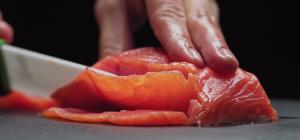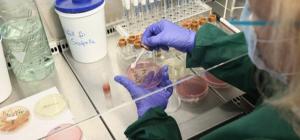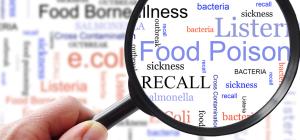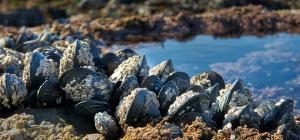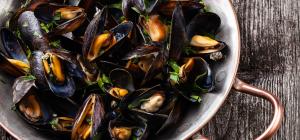
Black garlic: Food safety considerations during production and storage

Key Messages |
|
Introduction
Garlic is a well-known plant that is widely used around the world and throughout history as a spice and as a herbal remedy.1,2 It is rich in many organosulfur compounds, polyphenols, flavonoids, and carotenoids, many of which have antifungal, antibacterial, antioxidant, anti-cancer, anti-inflammatory, and cardio-protective properties.2-6 Despite the potential health benefits, people may be reluctant to consume raw/fresh garlic due to its pungent odour and spicy flavour caused by the presence of organosulfur compounds such as alliin and allicin (which are only produced when garlic is cut or crushed).1,2,7 In addition, several side effects such as nausea, vomiting, and other types of gastric discomfort associated with consumption of excessive amounts of fresh garlic have been documented.5,8
As a result of its taste and odour, garlic has been transformed into many different products such as garlic powder, garlic juice, and supplement pills in an attempt to make it more palatable.1 One of these products is black garlic. Some studies demonstrated that levels of biologically active compounds such as S-allyl cysteine, polyphenols, and flavonoids increased significantly in black garlic compared to fresh garlic, contributing to the higher antioxidant capacity of black garlic.7,9 In addition, multiple in-vitro and animal studies have shown that black garlic has anti-inflammatory, anti-obesity, hepatoprotective, anti-cancer, anti-allergy, immunomodulation, cardio-protective, and neuro-protective properties.1,2,9
While the author did not find any foodborne illness outbreaks associated with black garlic, there are food safety risks associated with black garlic if it is improperly processed or handled, especially in household settings. Many recipes for homemade black garlic in household appliances such as slow cookers or rice cookers can be found online, and the products may even be available for sale through private online platforms. This evidence brief will discuss the potential food safety risks associated with the production of black garlic and how to mitigate these risks.
Methodology
Literature search
A search of academic and grey literature in English that pertain to the health benefits of black garlic, its production methods, and associated food safety hazards was conducted in EBSCOhost databases (includes Medline, Cinahl, Academic Search Complete, ERIC, etc.) and Google Scholar, with no specific date restrictions. Keywords used for the database searches include the following:
(“black garlic” OR “black aged garlic” OR “fermented garlic” OR “black Allium sativum L”)
AND
(health OR benefit OR risk OR illness OR botulism OR outbreak OR safety OR toxicology OR toxicological OR enteropathogen OR enteropathogenic OR “e coli” OR gastroenteritis)
Other
(black AROUND(5) garlic OR “Allium sativum L”) OR (aged AROUND(5) garlic OR “Allium sativum”)
"black garlic" in title (black OR fermented) AND “functional food”
Additional keywords used in supplemental searches using Google and the University of British Columbia Library include variations of black garlic, fresh garlic, raw garlic, Clostridium botulinum, and Clostridium perfringens. Additional literature was identified through the reference sections of relevant literature in the above-mentioned search results.
Results
How is black garlic produced and what are the physicochemical changes during processing?
Black garlic is produced by aging fresh garlic (either unpeeled or peeled) in high-temperature (60–90°C) and high-humidity (70–90%) conditions for several weeks.1,7 During thermal treatment, several physical and chemical changes take place, resulting in a dark brown or black colour, chewy or jelly-like texture, and sweet and sour tastes. Processing temperatures and humidity levels of black garlic vary depending on regional recipes and desired product characteristics. While some refer to black garlic as fermented garlic, it is not a true fermented product as no active cultures are involved in its production.10 Rather, it is an oxidation and crystallization process.11 Heat treatment causes cell walls in the garlic to rupture, releasing the compounds within and allowing them to be transformed or degraded.7 During thermal treatment, alliin, allicin, and other organosulfur compounds responsible for garlic’s pungent odour are broken down and carbohydrates are reduced to simple sugars, which result in black garlic’s sweet taste.9,12 These sugars contribute to the Maillard reaction—a non-enzymatic browning reaction—which causes black garlic to take on its characteristic dark brown or black colour.1,7,9,12 The pH of black garlic declines during thermal processing due to the release of organic acids from the rupturing of cells as well as additional production of organic acids during thermal processing, resulting in a sour taste.13
Studies have found that processing technology, time, temperature, humidity, and pH can directly affect the amount of biologically active compounds as well as the moisture content and quality of the final black garlic product.1 High temperature results in faster browning, greater loss of moisture, shorter aging time, and an increase in bioactive compounds.14 A study by Zhang et al. found that at 90°C, although processing time was faster, the end product was more bitter and sour.14 The same study found that 70°C was the ideal temperature for the best black garlic product.14 Another study by Choi et al. found that at 70°C with 90% relative humidity (RH), 21 days of aging resulted in optimal levels of antioxidants, while moisture levels dropped by 50% after seven days of aging.15 The pH of the samples dropped gradually over the experimental period and reached 3.74 after 28 days of aging.15 Table 1 shows the moisture levels and pH of unpeeled garlic samples over the experimental period.15
Table 1. Moisture content and pH of unpeeled garlic samples at 70°C and 90% RH.15
|
Aging period (days) |
||||||
| 0 | 7 | 14 | 21 | 28 | 35 | |
| Moisture (%) | 64.21 ± 1.48 | 32.72 ± 0.97 | 31.77 ± 2.60 | 31.12 ± 0.17 | 29.55 ± 0.39 | 29.88 ± 0.49 |
| pH | 6.33 ± 0.07 | 5.49 ± 0.09 | 4.41 ± 0.17 | 4.22 ± 0.08 | 4.07 ± 0.02 | 3.74 ± 0.062 |
Toledano-Medina et al. found that when garlic was aged at higher temperatures, lower pH was reached more rapidly than at lower temperatures.16 Tables 2–4 show changes in water activity and pH for whole and peeled garlic samples aged at different temperatures at nearly 90% relative humidity.16
Table 2. Water activity and pH of whole and peeled garlic samples at 78°C and nearly 90% RH.16
|
Aging period (days) @ 78°C |
||||||||
|
|
0 |
5 |
10 |
14 |
||||
|
|
Whole |
Peeled |
Whole |
Peeled |
Whole |
Peeled |
Whole |
Peeled |
|
Water activity (Aw) |
0.97 ± 0 | 0.98 ± 0 | 0.96 ± 0 | 0.98 ± 0 | 0.94 ± 0 | 0.94 ± 0 | 0.93 ± 0 | 0.94 ± 0 |
| pH | 5.93 ± 0.01 | 6.31 ± 0.07 | 4.96 ± 0.01 | 5.22 ± 0.01 | 3.82 ± 0.07 | 4.19 ± 0.13 | 3.80 ± 0.06 | 3.74 ± 0.02 |
Table 3. Water activity and pH of whole and peeled garlic samples at 75°C and nearly 90% RH.16
|
Aging period (days) @ 75°C |
||||||||
| 0 | 7 | 14 | 21 | |||||
| Whole | Peeled | Whole | Peeled | Whole | Peeled | Whole | Peeled | |
| Water activity (Aw) | 0.97 ± 0 | 0.98 ± 0 | 0.96 ± 0 | 0.97 ± 0 | 0.93 ± 0 | 0.94 ± 0 | 0.94 ± 0 | 0.93 ± 0 |
| pH | 5.93 ± 0.01 | 6.31 ± 0.07 | 4.91 ± 0.07 | 5.08 ± 0.03 | 4.10 ± 0.04 | 4.11 ± 0.02 | 3.53 ± 0.04 | 3.52 ± 0.01 |
Table 4. Water activity and pH of whole and peeled garlic samples at 72°C and nearly 90% RH.16
|
Aging period (days) @ 72°C |
||||||||
| 0 | 11 | 24 | 33 | |||||
| Whole | Peeled | Whole | Peeled | Whole | Peeled | Whole | Peeled | |
| Water activity (Aw) | 0.97 ± 0 | 0.98 ± 0 | 0.96 ± 0 | 0.97 ± 0 | 0.93 ± 0 | 0.94 ± 0 | 0.91 ± 0 | 0.92 ± 0 |
| pH | 5.93 ± 0.01 | 6.31 ± 0.07 | 4.70 ± 0.06 | 4.87 ± 0.06 | 3.60 ± 0.01 | 3.72 ± 0.05 | 3.49 ± 0.06 | 3.52 ± 0.03 |
Pretreating raw garlic by freezing at 18°C prior to heat treatment increased the level of bioactive compounds and the overall quality of the end product, while speeding up the processing time.17 One study found that peeled raw garlic yielded black garlic with higher antioxidant capacity than whole unpeeled raw garlic.16
What are the potential food safety risks and how can they be mitigated?
Given the reported health benefits of black garlic, manufacturers and consumers will want to optimize the levels of beneficial compounds in black garlic and enhance its flavour and texture while preventing the growth of harmful pathogens. One of the pathogens commonly associated with fresh garlic is Clostridium botulinum.18 C. botulinum spores are prevalent in soil, aquatic segments, and the intestinal tracts of birds, animals, and fish.19 They can also be found in agricultural products such as honey and vegetables.19 C. botulinum spores can germinate in anaerobic conditions in the danger zone between 4°C and 60°C and produce botulinum neurotoxin, which may cause a rare but serious paralytic disease.19-21 The danger zone is the temperature range in which foodborne pathogens are able to proliferate the quickest to levels that may cause illness. C. botulinum and the neurotoxin are sensitive to heat, and the bacteria cannot grow below pH 4.6.22 However, the spores are resistant to heat and require much higher temperatures to be destroyed.22
As the processing temperature of black garlic is between 60°C and 90°C, the high temperature inhibits the growth of C. botulinum. During processing, once the pH reaches 4.6 or less and water activity (Aw) is 0.93 or less, the conditions further inhibit the growth of C. botulinum.22,23 It is imperative to follow Good Manufacturing Practices during processing to prevent the growth of pathogens, especially considering the length of time of the aging process. A temperature data-logger would enable monitoring of the processing conditions and ensure that the temperature is maintained at the optimal temperature above 60°C.20 Although black garlic can be made in household appliances such as slow cookers and rice cookers, it is unclear whether these appliances will be able to maintain the optimal temperature consistently over the aging period. Poorly ventilated or sealed household appliances may provide an anaerobic environment in which C. botulinum spores are able to germinate. Additionally, the use of such appliances over a lengthy period of time without constant supervision may pose a fire hazard. Therefore, it is not recommended to produce black garlic in household appliances.11
In order to prevent the growth of spoilage microorganisms and mould, the storage conditions of the final black garlic product are determined by the pH and Aw, as follows20,23:
- If pH is ≤ 4.2, the product is considered to be shelf-stable and may be stored at room temperature.
- If pH is > 4.2, the product must be refrigerated.
- However, if the pH is > 4.2 and Aw is < 0.85, the product is considered to be shelf-stable and may be stored at room temperature.
Summary
Black garlic has numerous potential health benefits and is increasing in popularity due to greater awareness of the linkages between food and human health. As a result, environmental public health practitioners may encounter black garlic products in the field while carrying out their duties. This document outlined the potential health benefits and discussed the potential food safety risks associated with improper production of black garlic. It is important to consistently monitor the equipment to ensure that the temperature is held at above 60°C at all times during processing to prevent the production of botulinum neurotoxin. In addition, proper storage of the final black garlic product is also imperative to prevent the growth of spoilage microorganisms and mould.
Acknowledgements
The author would like to acknowledge NCCEH staff Lydia Ma and Kelsey James for reviewing this document, as well as Michele Wiens for providing library support.
References
- Ahmed T, Wang CK. Black garlic and its bioactive compounds on human health diseases: a review. Molecules. 2021 Aug 19;26(16). Available from: https://doi.org/10.3390/molecules26165028.
- Marchese A, Barbieri R, Sanches-Silva A, Daglia M, Nabavi SF, Jafari NJ, et al. Antifungal and antibacterial activities of allicin: a review. Trends in Food Science & Technology. 2016 Jun 1;52:49-56. Available from: https://doi.org/10.1016/j.tifs.2016.03.010.
- Rahman K, Lowe GM. Garlic and cardiovascular disease: a critical review. J Nutr. 2006;136(3):736S-40S. Available from: https://doi.org/10.1093/jn/136.3.736S.
- Rahman K. Historical perspective on garlic and cardiovascular disease. J Nutr. 2001;131(3):977S-9S. Available from: https://doi.org/10.1093/jn/131.3.977S.
- El-Saber Batiha G, Magdy Beshbishy A, Wasef LG, Elewa YHA, Al-Sagan AA, Abd El-Hack ME, et al. Chemical constituents and pharmacological activities of garlic (allium sativum l.): a review. Nutrients. 2020;12(3):872. Available from: https://doi.org/10.3390/nu12030872.
- Zeng Y, Li Y, Yang J, Pu X, Du J, Yang X, et al. Therapeutic role of functional components in alliums for preventive chronic disease in human being. Evid Based Complement Alternat Med. 2017;2017:9402849. Available from: https://doi.org/10.1155/2017/9402849.
- Martinez-Casas L, Lage-Yusty M, Lopez-Hernandez J. Changes in the aromatic profile, sugars, and bioactive compounds when purple garlic is transformed into black garlic. J Agric Food Chem. 2017 Dec 13;65(49):10804-11. Available from: https://doi.org/10.1021/acs.jafc.7b04423.
- Hyung-Mun Y, Jung Ok B, Kyung-Ran P, Chong Kil L, Heon-Sang J, Sang Bae H, et al. Potential therapeutic effects of functionally active compounds isolated from garlic. Pharmacol Ther. 2014;142(2):183-95. Available from: https://doi.org/10.1016/j.pharmthera.2013.12.005.
- Lu J, Li N, Li S, Liu W, Li M, Zhang M, et al. Biochemical composition, antioxidant activity and antiproliferative effects of different processed garlic products. Molecules. 2023 Jan 13;28(2). Available from: https://doi.org/10.3390/molecules28020804.
- Encyclopaedia Britannica. Fermentation. Encyclopedia Britannica; 2023 [updated 2023 Jan 5; cited 2023 Mar 27]; Available from: https://www.britannica.com/science/fermentation.
- University of Minnesota Extension. Q: Is black garlic allowed as a cottage food? Cottage Food Q & A. Falcon Heights, MM: University of Minnesota Extension; 2022 [cited 2022 Oct 28]; Available from: https://blog-cottage-food.extension.umn.edu/2021/04/q-is-black-garlic-allowed-as-cottage.html.
- Zhang Z, Lei M, Liu R, Gao Y, Xu M, Zhang M. Evaluation of Alliin, Saccharide Contents and Antioxidant Activities of Black Garlic during Thermal Processing. Journal of Food Biochemistry. 2015;39(1):39-47. Available from: https://onlinelibrary.wiley.com/doi/abs/10.1111/jfbc.12102.
- Heng Y, Linjuan S, Min C, Jun W. An analysis of the changes on intermediate products during the thermal processing of black garlic. Food Chem. 2018;239:56-61. Available from: https://doi.org/10.1016/j.foodchem.2017.06.079.
- Zhang X, Li N, Lu X, Liu P, Qiao X. Effects of temperature on the quality of black garlic. J Sci Food Agric. 2016;96(7):2366-72. Available from: https://doi.org/10.1002/jsfa.7351.
- Choi IS, Cha HS, Lee YS. Physicochemical and Antioxidant Properties of Black Garlic. Molecules. 2014;19(10):16811-23. Available from: https://www.mdpi.com/1420-3049/19/10/16811.
- Toledano-Medina MA, Perez-Aparicio J, Moreno-Rojas R, Merinas-Amo T. Evolution of some physicochemical and antioxidant properties of black garlic whole bulbs and peeled cloves. Food Chem. 2016 May 15;199:135-9. Available from: https://doi.org/10.1016/j.foodchem.2015.11.128.
- Li N, Lu X, Pei H, Qiao X. Effect of freezing pretreatment on the processing time and quality of black garlic: Blackwell Publishing Ltd; 2015; 38(4): Available from: https://go.exlibris.link/m9VkSlnQ.
- Nichols J. Stinking facts about garlic. East Lansing, MI: Michigan State University Extension; 2015 [cited 2023 May 2]; Available from: https://www.canr.msu.edu/news/stinking_facts_about_garlic.
- Public Health Agency of Canada. Pathogen safety data sheets: infectious substances – clostridium botulinum. Ottawa, ON: PHAC; 2011 [updated 2011-04-19]; Available from: https://www.canada.ca/en/public-health/services/laboratory-biosafety-biosecurity/pathogen-safety-data-sheets-risk-assessment/clostridium-botulinum.html.
- Nummer B. Black garlic - food safety. Dr Brian Nummer. 2018 [Aug 19]; Available from: http://food-safety.guru/archives/1888.
- Health Canada. Food safety and you. 2021 [updated 2021 Jun 29; cited 2023 Apr 14]; Available from: https://www.canada.ca/en/health-canada/services/general-food-safety-tips/food-safety-you.html.
- US Department of Agriculture Food Safety Inspection Service. Food safety information: clostridium botulinum. Washington, DC: US Department of Agriculture; 2010. Available from: https://www.fsis.usda.gov/sites/default/files/media_file/2021-02/Clostridium_botulinum.pdf.
- US Food and Drug Administration. Water activity (aw) in foods. Silver Spring, MD: US FDA; 1984 [cited 2023 Apr 17]; Available from: https://www.fda.gov/inspections-compliance-enforcement-and-criminal-investigations/inspection-technical-guides/water-activity-aw-foods.

